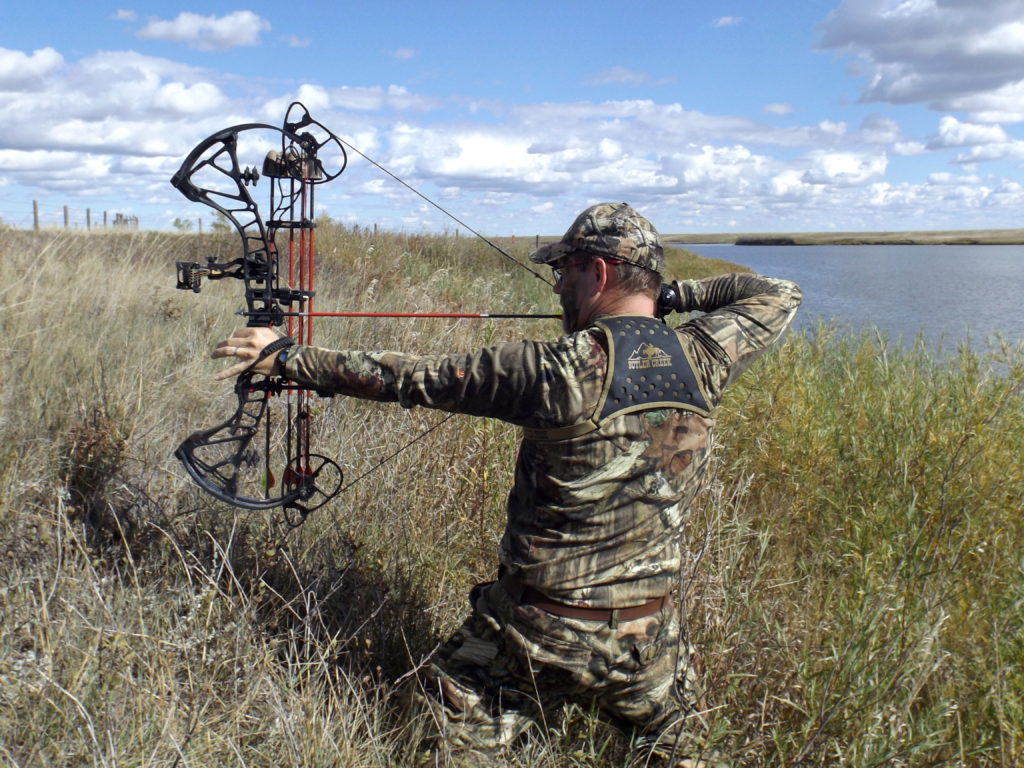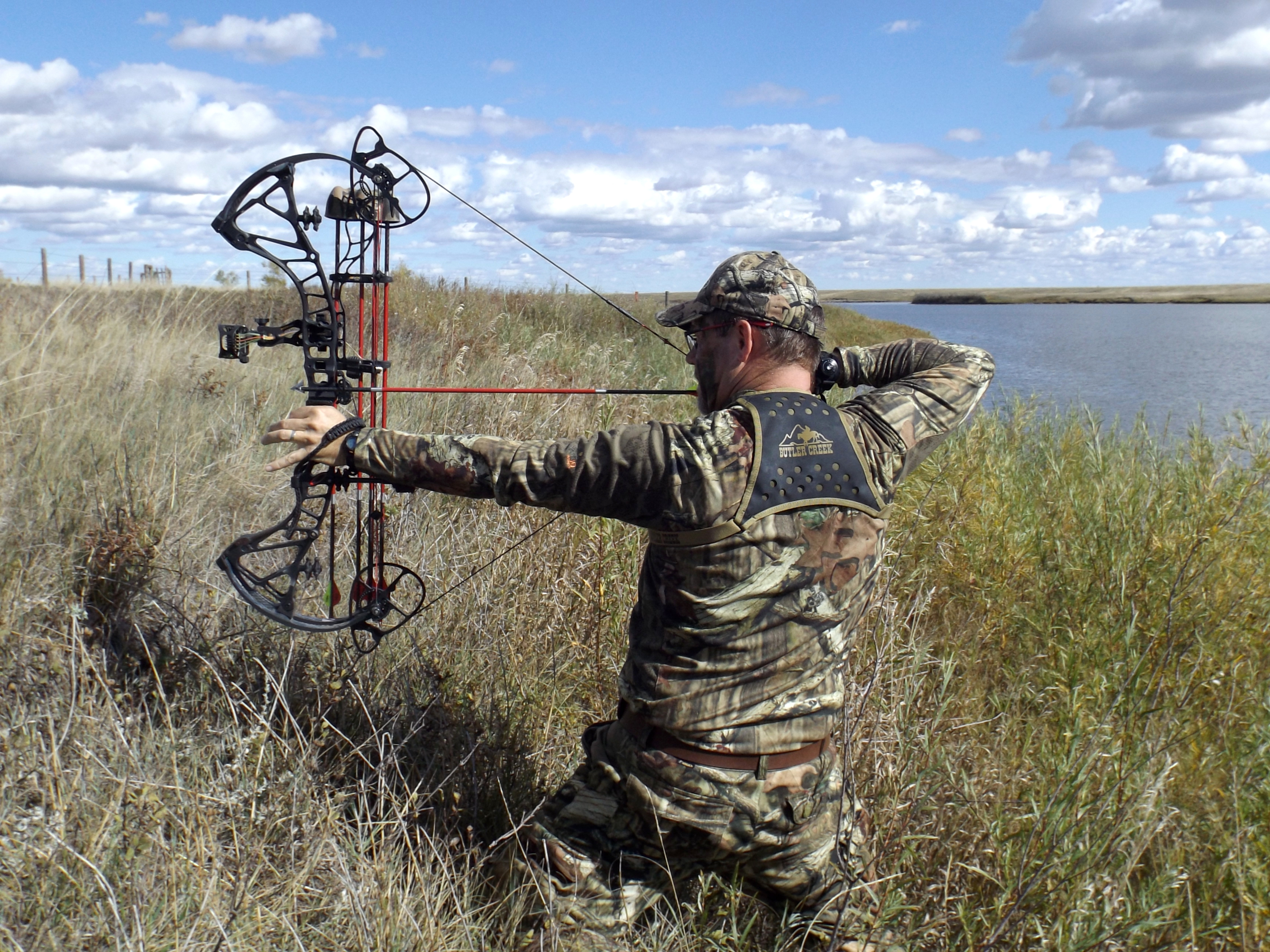About 25 minutes of daylight remained of the late-September evening when a handsome 140-class Wisconsin buck emerged onto the alfalfa field with a much smaller compadre. I’d arrowed a slightly larger buck from this stand a year earlier. Now, could I perform a repeat?
Rather than mosey into range, the pair walked the field edge directly away from me. Helplessly, I watched the fruits of my labor disappear back into the woods.
I hunted the stand several more times during the following days and weeks, but never saw that buck again. When all was said and done, I wished I would’ve climbed down and used the favorable wind to attempt a stalk. Shooter-buck sightings are rare in my neck of the heavily hunted woods, and sometimes you just have to make something happen. Would I have gotten close enough to launch a lethal arrow? I’ll never know because I didn’t attempt the stalk. More than seven years later, I’m still wondering if an aggressive move would’ve landed a better outcome.
Public vs. Private
If you own or lease manicured private ground, I strongly recommend hunting passively, which sometimes involves watching shooter bucks slip out of grasp. On public lands or pressured private ground, sometimes being aggressive is the best way to approach a hunt. Let me explain.
Uncontrollable factors abound on lands open to public hunting. At any given time, another hunter could walk in and hang a stand 10 yards away from yours. Or a bird dog and its owner could stumble past your stand at primetime, ruining the area for a week or longer. Consequently, you must do everything possible to capitalize when opportunities present themselves, because second chances are rare on pressured ground, as my Wisconsin anecdote suggests.
The Ground Stalk
For years, hunters have been successfully doing what I didn’t do on the aforementioned Wisconsin hunt, and that’s leaving the treestand for a ground mission. I get it; whitetails have incredibly keen senses, and outwitting them at eye level only becomes more challenging. However, you sometimes just have to go for it, especially on public land where one chance at a mature buck might be your only chance.
Jared Scheffler, of the popular DVD series, “Whitetail Adrenaline,” knows this as well as anyone. In fact, he strictly hunts bucks at ground level, exclusively on public lands — and with a longbow.
WATCH THE FULL PUBLIC & PRESSURED LAND DEER HUNTER SERIES
“Confined to a treestand, I believe my odds of arrowing a mature buck on public lands hover around 10%,” Scheffler said. “We now hunt exclusively from the ground so we can sort through lots of acreage in less time. We find the best spots this way, and we’re quite successful. If we screw up one stalk, we move on to the next. The sheer abundance of public ground enables us to be aggressive and really find where the action is happening.”
Believe it or not, Scheffler rarely scouts before hunting. His reason? First, he doesn’t have time to run trail cameras. And second, he knows the pains of becoming emotionally attached to a specific trail-camera star and holding out exclusively for that deer, only to eat a tag sandwich. He knows he needs to be flexible enough to shoot any mature buck.
When Scheffler sets out on foot, he and his cameraman walk at a good clip until they find a reason to slow down. “If things are cold in one spot, we continue moving until we find something that tells us the property is worthwhile,” he said. “We’re not confined to a 40-acre parcel. We’ve got thousands of public-land acres to work with, and mobility helps us cover more ground in less time. The sign we’re seeing determines our pace.
“One example is a fairly recent Iowa hunt where my cameraman and I covered about 30 miles in five days,” he said. “We sorted through lots of unproductive ground. On our final day, we hit pay dirt. We encountered three bucks in the 160- to 175-inch range. I never did get a shot opportunity, but we narrowed down tons of acreage to several productive pockets, which will help me greatly next time I pull an Iowa tag.”
Scheffler tailors his approach to the area he’s hunting. For example, he spends more time cruising roads and glassing when hunting wide-open plains states, but spends more time slinking through timber when hunting the Midwest.
In Kansas, specifically, Scheffler has successfully used a homemade decoy to pull bucks across wide-open country for archery-close shot opportunities. The footage on his DVDs will amaze viewers with aggressive — if a little wild — tactics. Scheffler is often seen running from Point A to Point B. And though his approach greatly differs from most bowhunters, he routinely brings down trophy bucks.
Scheffler tells the story of his 2013 Kansas buck, taken from behind his decoy. “He was with a doe in some fairly tall grass, so I deployed the decoy and inched forward to about 50 yards. He spotted it, laid his ears back and came to challenge it. At 7 yards, he was still coming when I shot him. I probably would’ve been mauled if I hadn’t shot!”
Desperate Times Call for Desperate Measures
Aggressive hunting has never been hammered home more than it was during a 2010 bowhunt on the South Dakota prairies. My efforts were vested on Walk-In Areas and Game Production Areas. After six days of zero mature-buck sightings, I knew I had to get aggressive and make something happen. Sounds a bit risky, right? Well, it proved to be the right move.
I picked out a small, less-than-200-acre Game Production Area I’d briefly scouted and hunted. I’d seen decent sign where I previously hunted, but only a couple of deer actually came past my stand. Before heading out again, I scoured an aerial image of the area, settled on a spot and headed out for the November 1 afternoon hunt with my bow, hang-on stand and climbing gear.
I picked out a tree within 150 yards of the parking area where multiple heavy trails converged. I knew they were being traveled by does, and with rubs scattered everywhere, I felt confident the spot would produce a mature-buck encounter, regardless of its proximity to the road.
Hanging my stand required more effort — and noise — than I’d hoped, but I eventually was all set up and ready for the evening. Behind me on adjacent private ground, several good bucks courted does in the corn stubble. I wished one would make a mistake and waltz past me, but only young bucks did that. With plenty of daylight left, I remained hopeful.

A mature doe soon crossed from private to public land — with no bucks on her tail. With an antlerless tag in my pocket, I drew my bow, planning to nab some tasty venison. When my arrow left the bow, everything felt great, but it lodged in a tree limb with a boisterous WHACK! Apparently, I hadn’t accounted for the arrow’s trajectory, which carried it above my sight pin and into the limb. The deer on the private land weren’t affected by the noise, but I wondered how it might affect the remainder of the evening on my side of the fence.
CHECK OUT OUR VENISON RECIPES AND TIPS
Approximately 45 minutes before dark, a snort-wheeze jolted my senses, and I immediately lifted my bow from its hanger. I soon caught glimpses of antlers through the trees, and eventually made out a respectable 10-point rack atop a barrel-bodied buck. He was trailing behind a 1 1/2-year-old buck. I prepared for a 30-yard shot, but the bucks chose another trail farther away. I zapped rangefinder readings, finally confirming the shot would be 43 yards. I drew and anchored tight, and when the buck was in the clear, I mouth-grunted to stop him. My arrow sliced the prairie air and smacked home, right on his shoulder’s crease. Hastily, he retreated in the direction he’d come from, and a loud crash signaled his fate.
My aggressive plan paid off with a gorgeous buck. If that hunt taught me one thing, it’s that when original plans aren’t panning out, change the pace and get aggressive.
Risk vs. Rewards
What separates private-land hunters from public-ground hunters — besides better hunting, of course — is that private-land hunters have something to lose when they get aggressive. Basically, if their aggressive move fails and they spook their target buck, it might relocate onto a neighboring property.
Public-ground hunters often hunt deer that bed on private ground anyway, and the public ground acts as a travel route from Point A to Point B. Spooking a buck on public land might mean he doesn’t come back through, but what have you got to lose? The one time you see him during daylight could easily be the only time you’ll see him. Go for it. If he skirts your treestand, get down and go after him, of course with the wind in your favor and sufficient cover with which to stay hidden.
Conclusion
The approaches I’ve covered here aren’t for everyone. But for the stealthy, energetic hunter who wants to make things happen, these could be your tickets to the show. I’ve notched my share of whitetail tags with an all-or-nothing approach, and you can, too.
— Darron McDougal is a driven white-tailed deer hunter and full-time freelance outdoor writer from Antigo, Wisconsin. He annually hunts whitetails deer across multiple states, primarily on public lands.
D+DH In-Depth is our premium, comprehensive corner on America’s No. 1 game animal. In this graduate-level course, we’ll teach you about deer biology, behavior, and ultimately, how to become a better hunter. Want to be the first to get our premium content? Become a D+DH Insider for FREE!


